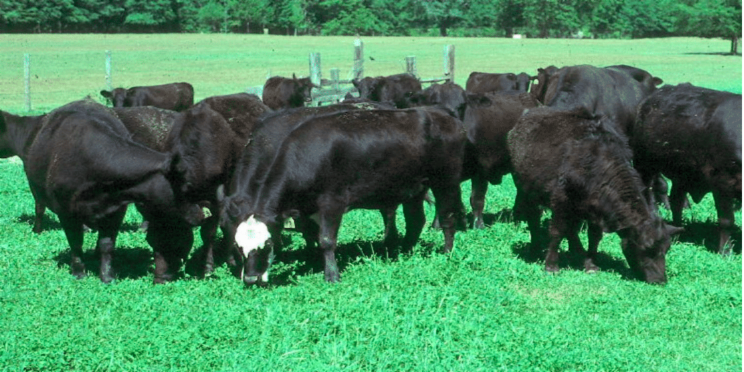
Grazing pressure refers to the extent to which pasture forage is being utilized at a given time. This is a function of stocking rate; i.e. the number of grazing animals that have access to a pasture. For example, if 30 cows have access to 60 acres of pasture, the stocking rate during that period of time would be 2 acres per cow (or ½ cow per acre).
Grazing pressure profoundly affects the vigor, productivity, and persistence of pasture plants and, in turn, greatly affects animal performance. Specific impacts(in the near and/or longterm)include effects on plant root mass and depth, forage quality, forage yield, soil quality, and pasture botanical composition. Grazing methods such as strip grazing and limit grazing are techniques that can alter grazing pressure or mitigate its effects.
Both extremes of the grazing pressure spectrum are undesirable. Overstocking weakens pasture plants and reduces leaf area, thus reducing the amount of sunlight captured. If carried far enough, overgrazing results in grazing animals getting an inadequate amount of pasture forage.
Understocking results in the presence of many older leaves that have lower efficiency of energy capture than young leaves, a higher percentage of wasted pasture forage, and a lower gain per acre. The “optimal zone” lies between the extremes. However, since pasture growth varies substantially over time in response to rainfall, temperature, fertilization, and other factors, an ideal stocking rate at onetime may be inappropriate soon thereafter, so periodic adjustments are needed.
When stored feed is relatively inexpensive, a cattleman may be inclined to err on the side of overstocking, because if pasture growth becomes limited heorshe can simply purchase hay or some other type of stored feed. However, during times when stored feed is expensive, pasture forage becomes relatively more valuable and the economic risk posed by being overstocked (or being close to it) becomes increasingly dangerous from an economic viewpoint.
Overstocking usually leads to overgrazing, lower forage yields, and reduced animal performance, as well as to higher amounts of stored feed needed. Therefore, on farms where stored feed needs are consistently high, it may be prudent to consider some reduction in overall stocking rates. Finding ways to utilize excess forage is preferable to purchasing high-priced stored feed.
It is especially helpful to lower the stocking rate just before available pasture forage is expected to decline. For example, the importance of culling open cows, especially before the winter feeding season, should be obvious. In such a situation, it may be desirable to purchase calves or other livestock to utilize pasture forage during the spring flush.
Another option might be to wean early and sell some calves in mid-summer. After all, as calves grow, their forage requirement increases, while pasture production at this time is typically declining. If managed properly, the remaining herd may be able to remain on pasture longer than would otherwise be the case. These or other strategies that alter stock numbers and grazing pressure at strategic times can lower the amount of stored feed required.
Foraging Ahead is a column presented by Ragan and Massey and written by Dr. Don Ball, Professor Emeritus at Auburn University. Dr. Ball is one of the authors of the popular book, Southern Forages, which can be found with a computer search that uses the words, “Southern Forages, The Fertilizer Institute.”
